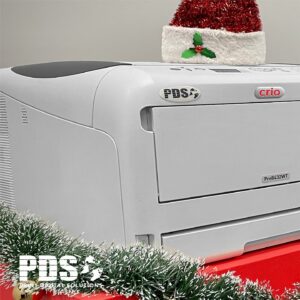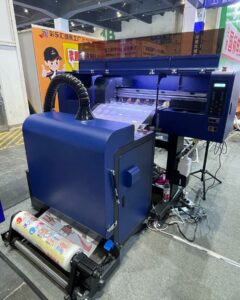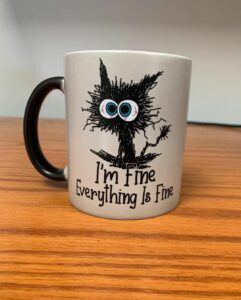White toner printer vs DTF printer: These two have become common choices on the market when it comes to printing high-quality graphics on a variety of surfaces. Even if both printers have distinctive characteristics and advantages of their own, picking the best one might be difficult.
In this article, we’ll contrast and compare white toner printers with DTF printers. We will discuss their benefits and drawbacks, maintenance costs, and instances in the real world when one printer can be favoured over the other. You will know more about which printer could be a good match for your particular printing requirements by the conclusion of this article. Now let’s get started!

DTF vs White Toner Printer Comparison
| Features | White Toner Printers | DTF Printers |
|---|---|---|
| Printing Quality | prints of exceptional quality, with true colours and delicate details. | High-quality prints with accurate colors and fine details. |
| Printing on Dark Garments | The degree of vibrancy may not be as high as that of DTF printers. | Printing white ink behind the colours results in more bright and opaque prints. |
| Printing on Light Garments | Can produce high-quality prints with accurate colors. | May not reach the same degree of detail or colour accuracy as white toner printers. |
| Durability | Prints may not last as long as DTF prints do over time. | Prints last longer and are less prone to break or peel over time. |
| Cost per Print | Lower cost per print compared to DTF printers. | When compared to white toner printers, the cost per print is higher. |
| Maintenance | Toner cartridges that are simple to change and maintain. | Requires maintenance of both the printer and the DTF film. |
| Printing Capacity | Can print on larger paper sizes. | There may be restrictions on the size of the film used in the printing process. |
| Environmental Impact | compared to DTF printers, uses more energy and generates more trash. | Consumes less energy and produces less waste compared to white toner printers. |
What is a White Toner Printer?

A white toner printer is a particular kind of printer that prints patterns on different surfaces. It uses a mixture of colourful toners and white toner. White toner printers, in contrast to conventional CMYK printers, have a separate white toner cartridge. This enables users to print on darker or colourful surfaces. Before adding the coloured toners to form the final design, the printer applies the white toner as an underbase.
| Pros | Cons |
|---|---|
| Greater flexibility in printing on darker and colored substrates. | More expensive than traditional CMYK printers. |
| High-quality prints with crisp details and vivid colors. | White toner cartridges are typically more expensive and may need to be replaced more frequently. |
| Relatively easy to use and do not require special skills or training. | May not be as durable as other printing technologies, particularly on fabrics. |
| Can print on a wide variety of surfaces. | Prints may crack or peel over time, especially after multiple washings. |
Overall, firms and designers wishing to print high-quality graphics on a range of surfaces should choose white toner printers. They are a good investment for various printing requirements since they provide tremendous flexibility and amazing outcomes.
DTF Printers

A DTF (Direct-to-Film) printer is a kind of printer that enables users to print patterns onto a specific film. It can then be transferred onto a number of substrates, including textiles, ceramics, and plastics. The printer employs a unique DTF ink. This ink is designed to stick to the film and produce vivid colours and precise details.
| Pros | Cons |
|---|---|
| Can produce high-quality prints with vibrant colors and sharp details. | Films can be expensive and may need to be replaced frequently. |
| Can print on a wide range of surfaces, including fabrics, ceramics, and plastics. | Requires some level of technical expertise and training to operate. |
| Prints are durable and can withstand multiple washings and handling. | Requires specialized equipment and supplies. |
| Cost-effective for printing larger quantities of designs. | May require more time and effort to produce designs compared to other printing technologies. |
DTF printers are a great choice overall for companies and designers searching for a practical approach to create high-quality, long-lasting prints on a range of surfaces. They can print on a variety of surfaces and generate higher numbers of designs. This fact makes them a beneficial investment for various printing requirements, even if they need for a certain amount of technical know-how and specialised equipment.
Comparison between White Toner Printers and DTF Printers
Printing Technology: DTF printers produce graphics onto a specialised film. This film is subsequently transferred onto the substrate. white toner printers employ a mix of coloured toners and white toner to print designs directly onto the substrate.
Printing Surfaces: You can print on a variety of surfaces, including textiles, ceramics, and polymers using both white toner and DTF printers. Nevertheless, DTF printers are suitable for printing on porous and textured surfaces. White toner printers provide more versatility when it comes to printing on darker or colourful substrates.

Print Quality: Both white toner and DTF printers are capable of producing prints of excellent quality, with vivid colours and fine details. Nevertheless, whereas DTF printers provide superior ink adherence and durability, white toner printers often yield somewhat better colour fidelity.
Equipment and Supplies: Apart from the printer itself and the toner cartridges, white toner printers are rather simple to set up and operate. They also need very little specialist equipment or materials. DTF printers need more specialist tools, such a heat press, and specific films, which may be more costly and may need to be updated more often.
Durability: Prints from white toner and DTF printers are both resistant to handling and numerous washings. Although DTF prints provide superior ink adherence and durability, white toner prints may be more prone to cracking or peeling over time on materials.
Cost of ownership
White Toner Printers:
White toner printers often cost more up front than conventional CMYK printers. Costs might range from several hundred dollars to several thousand dollars, depending on the particular model and features. Refer to this case study by Digital Heat FX for a precise printing costs.
Consumables: The toner cartridges, which are often more costly than conventional CMYK cartridges, are the key consumable for white toner printers. The cost of ownership may also increase if we need to change the white toner cartridge more often than the other colour cartridges.
Maintenance: To keep white toner printers functioning properly, they need to get regular maintenance. This can include cleaning the fuser unit and changing out worn components like the transfer belt or drum. However, maintaining a white toner printer is less cumbersome as compared to a DTF one. Depending on the model and use, maintenance costs might vary. It’s crucial to account for these recurring expenses when calculating the overall cost of ownership.
DTF Printers:
DTF printers may cost anything from a few hundred dollars to several thousand dollars up front, depending on the type and capabilities. This printing method needs specific hardware in addition to the printer itself, such a heat press.
Consumables: The film, which is the primary consumable for DTF printing, may be more costly than the conventional transfer sheets used in other printing processes. The kind, brand, and size of the design you’re printing, as well as the precise type and brand chosen, affects the price of the film.
Maintenance: To maintain DTF printers in excellent operating condition, they need to get regular maintenance. This can include calibrating the printer, changing out worn components, and cleaning the printhead. If your business requires small batch productions, HVT printing is a good alternative over DTF.
DTF or White Toner- Which Printer is Preferred & When?

There are various real-life situations where businesses prefer one type of printer over the other. Here are a few examples:
- Printing on Dark Garments: Since DTF printers can print white ink underneath the colors, they are more suitable for printing on dark or colorful clothes. The design becomes more vivid and opaque as a result. White toner printers, may not be able to print white ink below the colors. This leads to a less brilliant design.
- Printing on Light Garments: People favor white toner printers for printing on light or white clothing. They can produce prints with fine details and true colors that are of a high quality. When printing on light clothing, DTF printers may not be able to provide the same amount of detail or color fidelity.
- Big Format Printing: Due to its capacity to print on larger paper sizes, you can select white toner printers for large format printing. Due to the limits of the film used in the printing process, DTF printers may not be able to support bigger paper sizes.
Other factors to consider:
- Cost: White toner printers is used for one-off designs or smaller print runs. They have a lower cost per print than DTF printers. Nevertheless, since the film used in the printing process is often less expensive than white toner cartridges, DTF printers may be more cost-effective for longer print runs or designs with several colors. If you are looking for white-toner alternative, sublimation printing could be an answer.
- Durability: DTF printers are often used for printing designs that need great durability and long-lasting prints, such sports jerseys or promotional products. This is due to the fact that DTF prints, as opposed to white toner prints, are less prone to fracture or peel over time.
Ultimately, the decision to use a white toner printer or a DTF printer comes down to the particulars of the printing project. This includes the kind of garment or fabric, the amount of detail needed, and the anticipated longevity of the print.
Is DTF and white toner printer the same?
No, white toner printers and DTF printers are not interchangeable. Both kinds of printers employ diverse printing processes, but they can print on a variety of materials.
White toner printers utilize toner cartridges to print images on transfer sheets or paper. These are then used to transfer the images to the medium being printed on using a heat press or other transfer techniques. DTF printers employ a specific film that is printed with a particular ink. This PET film is transferred using heat and pressure onto the garment or material being printed on.
The primary difference between the two printing methods is that DTF printers can print white ink underneath colored ink, producing prints that are more vivid and opaque on dark or colorful clothes. When printing on dark or colorful clothes, white toner printers, on the other hand, may not be able to attain the same degree of brightness.
Can you print white with DTF printer?
A DTF (Direct to Film) printer can produce white prints, thus the answer is yes. In fact, one benefit of DTF printing is its capacity to print white ink underneath the colors, producing images that are more vivid and opaque on dark or colorful clothes.
We use an specific white DTF film with a DTF printer to print in white. The colorful ink is printed on top of the white ink after it has been printed onto the film. The white ink shows through under the colorful ink when the film is heated and pressed into the garment or material being printed on, creating a striking and opaque print.
Conclusion | DTF vs WTT Printers
In conclusion, we spoke about the differences between DTF and white toner printers. DTF printers utilize a specific film that is subsequently transferred onto the garment or material being printed on. White toner printers use toner cartridges to produce patterns onto paper or transfer sheets.
We have also covered the benefits and drawbacks of each kind of printer, along with ownership and maintenance costs. Although DTF printers are more suited for printing on dark clothing and creating more lasting prints, white toner printers are often more economical and simpler to operate.
It ultimately relies on the precise requirements of the task when determining which kind of printer is most suited for various printing demands. DTF printers are good for printing on dark-colored textiles or apparel.
White toner printers are advised for printing on light clothing or textiles and creating prints of excellent quality and fine detail. White toner printers may be more cost-effective for bigger print runs or one-off designs, whereas DTF printers may be more cost-effective for larger multicolor patterns.
In general, choosing the best solution for your particular printing requirements may be aided by being aware of the distinctions between white toner printers and DTF printers.
FAQs
Sure, white toner printers can print on dark clothing, however the color vibrancy they produce may not be as good as what DTF printers can. With the help of toner cartridges, white toner printers employ a heat transfer technique where the pattern is printed on a transfer sheet. This sheet is then heated and pressed onto the clothing.
DTF printers can print on light-colored clothing, but they may not produce images with as much detail or as accurate a color as white toner printers. Using pressure and heat, a special film printed with a particular ink is transferred onto the item of clothing or material being printed on by DTF printers.
Each printer’s cost-effectiveness is influenced by a variety of variables. This includes its model, the materials it uses, and the quantity of prints needed. White toner printers often cost less per print than DTF printers.However, DTF printers have the benefit of printing white ink underneath the colors, producing prints that are more vivid and opaque on dark or colorful fabrics.
DTF prints are often more durable than prints generated by white toner printers. The ink used in DTF printing is more flexible and less prone to fracture or peel over time compared to toner-based prints.
We believe DTF printers are more eco-friendly than white toner printers. DTF printers utilize less energy and generate less trash compared to white toner printers.
Yes, white toner printers may print on a range of materials, including plastics and metal, as long as they are compatible with the heat transfer method the printer employ.
DTF printers are intended mainly for printing on fabric and textile materials. They may not be suited for printing on hard, non-textile surfaces like mugs or phone covers. Nevertheless, certain DTF printers may be compatible with specialist films or coatings that enable for printing on some kinds of non-textile materials.

Ashley Wang is a skilled sales manager with knowledge in DTF printing. She presently works for ShenLan Digital, a reputable DTF printer maker. Ashley is the best person to offer advice on selecting the most suitable DTF printer because she has tested a lot of them. She launched DTFPrinterSchool to educate individuals and organizations about DTF printing technology, providing her expertise and observations on the most recent advancements in the sector. Ashley is an invaluable resource for businesses and individuals wishing to invest in DTF printing technology because of her expertise and experience in the industry.
